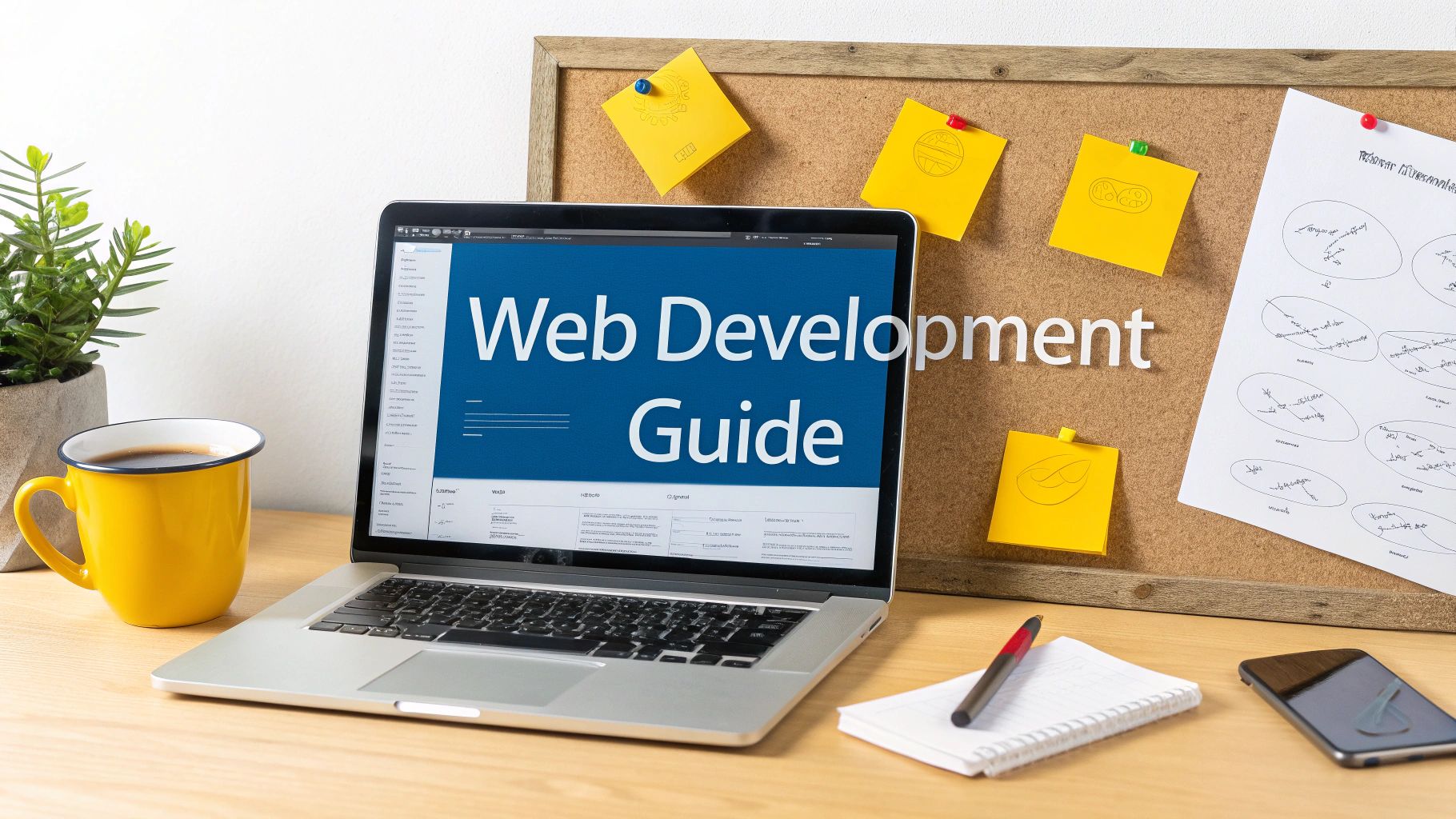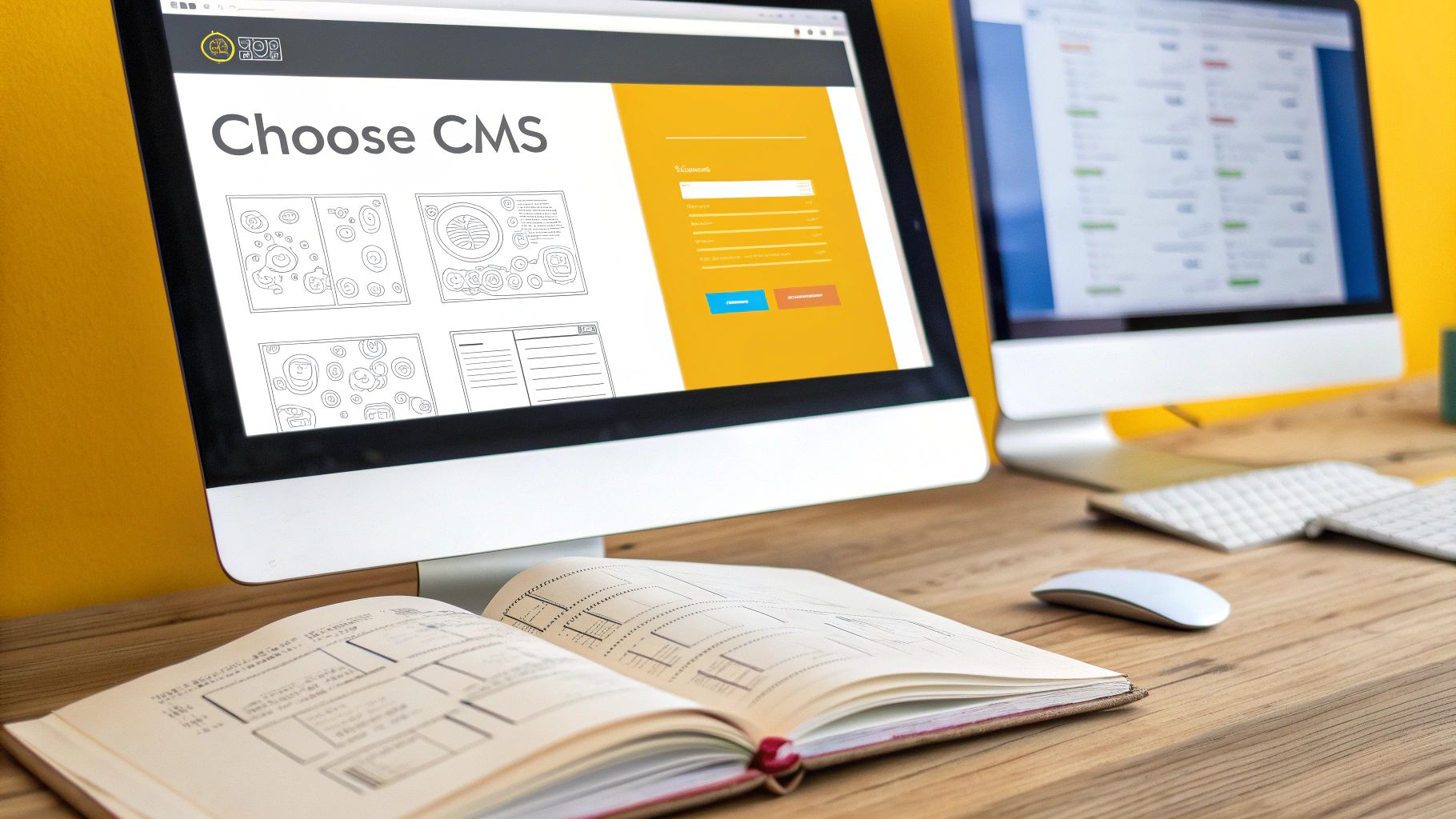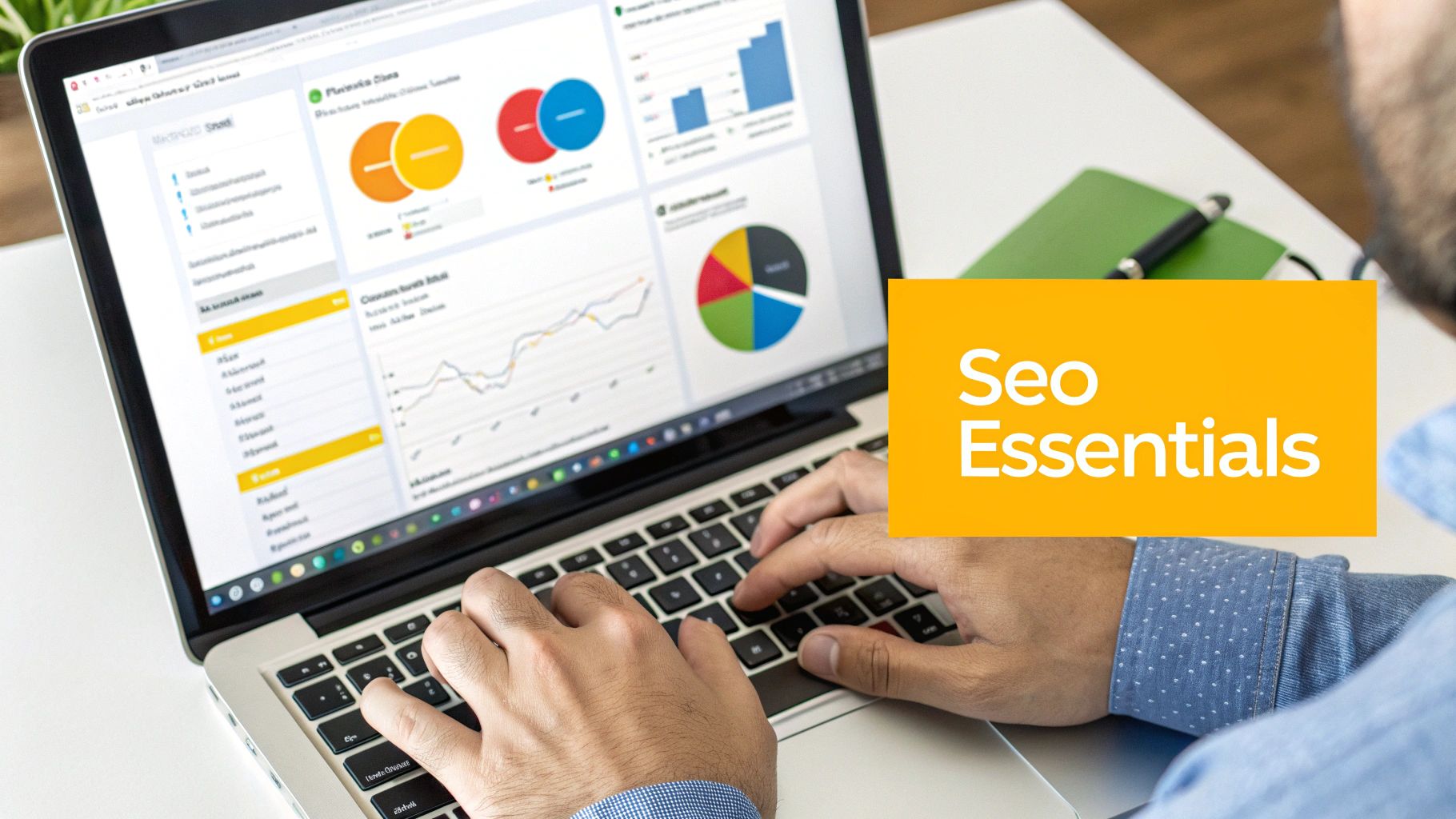Web Development for Small Businesses: Boost Your Online Presence

Think of the best employee you could ever hire. This person works 24/7, never takes a sick day, and is an absolute expert at guiding customers to the perfect solution. That’s exactly what a well-built website does for your small business. It’s not just an online placeholder; it's your single most valuable business asset.
Your Website Is Your Best Employee

For a small business, a website is much more than a digital address—it's an active engine for growth. It works around the clock to build your credibility, capture new leads, and even handle customer support long after you’ve locked up for the night. Your website is the central hub for every single one of your marketing efforts.
Let's face it, without a professional online presence, you’re practically invisible to a huge slice of your market. The modern customer journey almost always starts with a Google search. In fact, compelling research shows that more than 81% of shoppers do their homework online before ever making a purchase. That stat alone shows why having a dedicated website is so urgent—it’s your first and best chance to capture that initial buyer interest.
This reality has shifted websites from being a "nice-to-have" luxury to a standard operational requirement. It’s a fundamental tool for connecting with customers and, ultimately, making sales.
A Powerful Engine For Growth
A website that's built with purpose does more than just sit there looking pretty; it actively performs critical business functions that directly impact your bottom line. It stops being a passive page and starts participating in your daily operations.
Just think about all the hats your website can wear:
- Your 24/7 Sales Agent: While you're busy running the business, your site is showcasing products, explaining services, and answering frequently asked questions for visitors from all over the world.
- Your Credibility Cornerstone: A polished, professional site instantly builds trust. It tells potential customers you’re a legitimate business, making them far more comfortable choosing you over a competitor who might be missing this key piece.
- Your Lead Generation Machine: Through simple contact forms, newsletter sign-ups, and quote requests, your website automatically captures valuable information, building a pipeline of potential customers for you.
To be a true growth engine, a website needs to perform several core functions seamlessly. The table below outlines the most crucial goals for any small business website.
Key Website Goals for Small Business Growth
| Business Goal | How a Website Achieves It | Key Metric to Track |
|---|---|---|
| Increase Brand Awareness | Attracts visitors through search engines (SEO) and social media, establishing your brand's presence. | Organic Traffic, New Users |
| Generate Quality Leads | Uses forms, calls-to-action, and downloadable content to capture contact information from interested visitors. | Conversion Rate, Leads Generated |
| Build Trust and Credibility | Showcases testimonials, case studies, professional design, and clear contact info to build confidence. | Time on Page, Bounce Rate |
| Drive Sales and Revenue | Facilitates direct online purchases (e-commerce) or guides users to contact a sales team. | Online Sales, Quote Requests |
| Provide Customer Support | Offers FAQs, knowledge bases, and contact options to help customers find answers quickly, 24/7. | Support Tickets Deflected, FAQ Page Views |
These goals transform your website from a simple online brochure into a strategic tool that actively contributes to your success.
From Digital Brochure To Business Asset
The key is to shift your perspective. Stop seeing your website as a static, one-time expense and start viewing it as an investment in an asset that grows in value over time. Every new blog post, every customer testimonial, and every link you earn from another site increases its authority and power.
The right approach to web development for small businesses is all about building a high-performing tool, not just an online business card. It’s about creating a digital employee that works tirelessly to grow your brand, connect with your customers, and drive real revenue. This guide will walk you through exactly how to build one.
Creating Your Website Blueprint for Success

You’d never build a house without a blueprint, right? Diving into construction without a plan is a surefire way to waste money, blow your budget, and end up with a house that doesn't feel like a home. The very same logic applies to building a website for your small business. A solid plan is everything.
This early strategic work is the secret sauce. It’s what separates a website that actually helps your business grow from one that just sits there. It turns a chaotic guessing game into a focused project with clear goals. So, before anyone even thinks about writing a line of code, we need to get crystal clear on what you're building and why.
This means getting specific. Vague goals like "I want more customers" just won't cut it. Instead, you need concrete, measurable targets. Think: "Increase online quote requests by 25% within six months" or "Capture 50 new email subscribers every month." Now that's a plan.
Define Your Ideal Customer
Here’s a hard truth: you can't build a website for everyone. When you try, you end up with a generic site that doesn’t really speak to anyone. So, the first step in your blueprint is to paint a vivid picture of your ideal customer, what's often called a customer persona.
Go deeper than just their age and location. What are the real-world problems they're facing that you can solve? What questions are they actually typing into Google when they need help?
A sharp, well-defined customer persona becomes your North Star. It guides every single decision you make—from the colors and fonts you choose to the words you write on your homepage. It’s how you make sure your website talks directly to the people who matter most.
When you truly understand your audience, you can craft a message that makes them feel seen and understood. That's the connection that turns a first-time visitor into a repeat customer.
Map the User Journey and Sitemap
Okay, so you know who you're talking to. Now, how will they move through your site? This is called user journey mapping. Put yourself in their shoes. A potential customer just landed on your homepage for the first time. What’s the single most important thing you want them to do next?
This path should feel natural and effortless, gently leading them from one step to the next. For example, a journey might look like this: a visitor reads a blog post, clicks a link to a related service page, and then fills out your contact form for a consultation.
This journey map then directly shapes your sitemap, which is basically the architectural plan for your website. It’s a simple outline of all your pages and how they connect. For most small businesses, a solid sitemap includes these essentials:
- Homepage: Your digital front door.
- About Us: Your story, your team, and why people should trust you.
- Services/Products: Clear, detailed explanations of what you sell.
- Blog: The hub for your expertise and a huge asset for SEO.
- Contact: Obvious, easy-to-find ways to get in touch.
Analyze Your Competition
Finally, remember that you’re not building your website in a bubble. A little bit of competitor research can uncover some incredible opportunities. Take a look at the websites of your top three competitors.
As you browse, ask yourself a few simple questions:
- What are they doing well? Make a note of their clean design, persuasive copy, or fantastic blog posts.
- Where are they dropping the ball? Is their site clunky on a phone? Hard to navigate? Are they missing crucial social proof like testimonials?
- What aren't they doing at all? This is where you can find your opening. Maybe none of them have an online booking tool or a free downloadable guide.
This isn't about copying what they do. It's about finding the gaps in the market that your website can fill, giving you an immediate competitive edge. This blueprint—built from clear goals, a deep customer understanding, a logical sitemap, and smart competitor insights—is the most important part of the entire web development process. It ensures you’re not just building a website, but a powerful engine for your business's growth.
2. Choosing Your Path: DIY vs. Hiring a Pro

Now that you've sketched out your website's blueprint, you've arrived at a classic fork in the road for every small business owner. Do you roll up your sleeves and build it yourself, or do you bring in a professional? This one decision will ripple through your budget, timeline, and what your site can ultimately do for your business. It's the age-old trade-off: do you invest your time or your money?
Let’s use an analogy. The Do-It-Yourself (DIY) path, using platforms like Wix or Squarespace, is a lot like renting a beautifully furnished apartment. You can move in quickly, it’s affordable, and all the basics are ready to go. On the other hand, hiring a professional developer is like building your dream home from the ground up. The upfront investment is bigger, but you get total creative control over every last detail.
The numbers show just how divided small businesses are on this. While 71% of small businesses have a website, how they get there varies. Roughly 46% handle it with in-house staff, while 32% opt for DIY website builders. It’s a constant balancing act between keeping costs low and achieving a truly professional online presence.
So, how do you decide which path is right for you? Let's break it down.
The Case for DIY Website Builders
DIY platforms have completely changed the game, making it possible for almost anyone to get online. The main draw is how easy they make it—both on your wallet and your technical skills. You don't need to write a single line of code to launch a good-looking, functional site, often in just a weekend.
A DIY builder is probably your best bet if:
- Your budget is tight. You can get started with a small monthly fee instead of a large upfront payment.
- Your needs are simple. If all you need is a basic "brochure" website—a homepage, about page, services list, and contact form—these tools are more than capable.
- You want to make quick updates yourself. Need to change some text, swap out an image, or publish a blog post? You can just log in and do it instantly.
But this convenience has its limits. You're essentially building on rented land. Your customization options are confined to the templates and tools the platform offers. Down the road, if you need a unique feature or a special integration, you might hit a dead end. If you go the DIY route, it's worth your time comparing various website builder tools to find the one that fits you best.
When to Hire a Professional Developer
Hiring a freelance developer or a web design agency is a much bigger investment, but it’s one that pays off in scalability, ownership, and performance. This is the right move for businesses that see their website as a powerful growth engine, not just an online placeholder.
A professional build gives you true ownership. It’s a digital asset that belongs entirely to you, built on an open-source platform like WordPress, which means you can take it to any developer or hosting provider in the future.
This approach makes the most sense when:
- You have custom needs. If your business relies on specific functions like a custom booking engine, a private client portal, or complex e-commerce features, you'll need a developer.
- Scalability is a top priority. A custom-built site is designed to grow right alongside your business. It can handle more traffic, more features, and more complexity without needing a complete overhaul later.
- SEO is critical for your success. Professionals build sites with technical SEO best practices baked in from day one—from clean code to fast load times—giving you a real advantage in Google search results.
While the upfront cost is higher, it often prevents bigger expenses down the line, like the painful process of migrating away from a limited DIY platform. This is a common growing pain for new companies, a topic we cover in more detail in our guide on web development for startups, which explains how to plan for future growth from the very beginning.
To make this choice clearer, let's put the two options side-by-side.
Website Platform Comparison: DIY Builder vs. Professional Development
| Factor | DIY Website Builder (e.g., Wix, Squarespace) | Professional Development (e.g., Custom WordPress) |
|---|---|---|
| Cost | Low monthly subscription fees. Minimal upfront cost. | Higher upfront investment. Lower ongoing costs. |
| Time to Launch | Very fast. Can be live in a weekend. | Slower. Typically takes several weeks to months. |
| Ease of Use | High. Drag-and-drop interfaces, no code needed. | Low. Requires technical expertise to build and manage. |
| Customization | Limited to platform templates and features. | Nearly limitless. Can be built to exact specifications. |
| Scalability | Poor. Can be difficult to add complex features later. | Excellent. Built to grow with your business. |
| Ownership | You are "renting" the platform. Difficult to move your site. | You own 100% of the code and design assets. |
| SEO Potential | Good for basics, but limited for advanced technical SEO. | Excellent. Optimized from the ground up for search engines. |
Ultimately, the right choice boils down to your specific business needs, your budget, and your long-term goals. Carefully weighing these factors is the key to setting your website—and your business—up for success.
Designing a Website Your Customers Will Love

Great design is so much more than just picking a few nice colors and trendy fonts. It’s really about psychology and strategy. When we talk about web development for small businesses, the very best designs are the ones that feel invisible—because they make everything so effortless for the visitor.
This is where two critical concepts come into play: User Experience (UX) and User Interface (UI).
Let's think of your website as a physical store. The UI is the beautiful storefront, the inviting sign, the clean windows, and the stylish decor inside. It's everything your customers see and interact with visually.
UX, on the other hand, is the store's practical layout. It’s the wide, uncluttered aisles that let people move freely, the clear signs pointing to different departments, and the quick, no-fuss checkout counter. You can have the most beautiful shop in the world (great UI), but if customers can't find what they need or get stuck in a long line (poor UX), they'll walk out frustrated, probably for good. Both have to work together.
The Pillars of a Great User Experience
To build a website your customers will genuinely enjoy using, you have to nail a few non-negotiable UX principles. These aren't just buzzwords; they're the foundation for how people will feel about your business online. A good experience shows you respect your customer's time.
First, your website needs simple and intuitive navigation. A visitor should land on your site and instantly know where to find your services, learn about your company, or get in touch. If they have to hunt for basic information, you've already lost them.
A confused mind always says no. The moment a visitor feels lost or overwhelmed by your website, they are one click away from leaving and going to a competitor. Simplicity isn't just a design choice; it's a conversion strategy.
Second, your site must have clear calls-to-action (CTAs). These are the buttons and links that tell visitors what to do next, like "Get a Free Quote," "Shop Now," or "Contact Us Today." They need to stand out visually and use direct, action-oriented language to guide people along their journey. If you really want to make your CTAs as powerful as possible, it's worth implementing some effective conversion rate optimization tips.
Mobile-First Design and Accessibility
It’s no secret that more people browse the internet on their phones than on desktops. This shift means mobile-first design isn't just a good idea; it's essential. This approach flips the old process on its head: you design the mobile version of your website first, and then adapt it for larger screens like tablets and desktops. It forces you to prioritize what’s truly important, leading to a cleaner, more focused experience for everyone.
Just as important is accessibility. Your website should be usable by everyone, including people with disabilities. This involves practical steps like using high-contrast colors, providing descriptive text for images (alt text), and making sure your site can be navigated with a keyboard alone. Not only is this the right thing to do, but it also opens your doors to a wider audience. We cover this in more detail in our guide on how to https://getnerdify.com/blog/how-to-make-website-accessible.
By focusing on these core design principles, you’re creating much more than a website. You’re building a welcoming, effective, and trustworthy digital storefront that turns casual visitors into loyal customers.
Getting Found on Google With SEO Fundamentals
You can have the most brilliant website in the world, but it’s completely useless if no one can find it. This is where Search Engine Optimization (SEO) comes into play. Think of SEO as the ultimate filing system for your online storefront; it tells search engines like Google exactly what you do, making sure you show up when customers are looking for you.
Without a solid SEO foundation, even the most beautiful website will be invisible. Building this foundation from day one is one of the most critical parts of web development for small businesses. It’s not about memorizing secret formulas or trying to outsmart Google. It’s simply about communicating your value in a way search engines can easily understand.
Let’s break down what this really means for you. By focusing on a few key areas, you can give your new website a huge head start in attracting the right kind of traffic—the kind that turns into paying customers.
What Your Customers Are Searching For
At the heart of any good SEO strategy is keyword research. This is just a fancy term for figuring out the exact words and phrases your ideal customers type into Google when they need what you sell. You’re essentially reading their minds.
Are they searching for "local plumber near me" or "emergency pipe repair"? Do they look for "best gluten-free bakery" or "custom birthday cakes"? The difference is everything.
Start by brainstorming a simple list of topics related to your business. From there, you can use free tools like Google Keyword Planner to see what people are actually searching for. Aim for a healthy mix of broad terms and more specific, "long-tail" keywords. For instance, "landscaping" is incredibly competitive, but a phrase like "drought-resistant garden design in Austin" is far more targeted and will attract a much more qualified lead.
Optimizing Your Website Pages
Once you know what your customers are searching for, you need to place those keywords strategically across your website. We call this on-page SEO. It’s how you signal to Google that a specific page on your site is the perfect answer to a specific search.
The old method of just stuffing keywords everywhere is long dead and will get you penalized. Instead, weave them naturally into these key places:
- Page Titles: This is the main headline that appears in a browser tab and on Google’s search results page.
- Meta Descriptions: The short blurb of text under the title in search results. While not a direct ranking factor, a great description is your sales pitch—it convinces people to click.
- Headings and Subheadings (H1, H2, H3): Use your main keyword in your page’s primary heading (the H1) and related phrases in subheadings to create a clear, logical structure.
- Content and Images: Sprinkle your keywords naturally throughout your website copy. Also, use them in the "alt text" for your images, which is the description that helps search engines (and visually impaired users) understand what your images show.
Site Speed: The Silent Business Killer
When it comes to SEO, speed is everything. A slow-loading website is one of the fastest ways to lose a potential customer and sink your search engine rankings. Google actively prioritizes sites that offer a fast, seamless user experience, and a sluggish site is the digital equivalent of a slammed door.
Think about it from a customer's perspective. If a page takes more than a few seconds to load, you don't wait around—you hit the "back" button and head to a competitor. Every second of delay exponentially increases the chance a visitor will leave.
Website speed is a massive challenge for many businesses. It's shocking, but the average desktop site takes 10.3 seconds to fully load, and mobile load times can drag on for an agonizing 27.3 seconds. Considering most people will bail if a site takes more than three seconds to load, this performance gap is a silent killer for business growth. You can explore more surprising web design stats and their impact in this comprehensive report from WebFX.
Ensuring your site is fast isn't a one-time fix; it requires constant attention to details like optimizing images and maintaining clean code. If you find your site is struggling to keep up, check out our guide on how to improve website speed for practical tips. Building your site for visibility from the start means making SEO and speed non-negotiable priorities.
Here is the rewritten section, designed to sound like an experienced human expert:
Keeping Your Website Healthy and Secure
So, your website is live. Pop the champagne, right? Well, yes, but don't put the bottle away just yet. Launching your site isn’t the finish line; it's the starting gun.
Think of your new website like a car you just drove off the lot. It’s shiny, fast, and everything works perfectly. But if you skip the oil changes, ignore the tire pressure light, and never take it to the car wash, it won't be long before it starts looking rough and running poorly. Your website is no different. Ongoing maintenance is what keeps that initial investment paying dividends.
This is the part where so many business owners stumble. They see the launch as the end of the project, but a website is a living, breathing part of your business—not a static, one-and-done brochure. Regular tune-ups protect you from hackers, keep your pages loading quickly, and allow your site to grow alongside your company. Skipping this step is like leaving the front door of your shop wide open overnight.
The Non-Negotiables of Website Maintenance
Putting together a maintenance checklist doesn't have to be a huge headache. It really just comes down to a few core habits that protect your site's performance and integrity. These are the absolute must-dos that shield your business and your customers from problems you could have easily avoided.
A smart maintenance routine always covers these bases:
- Consistent Backups: This is your big red "undo" button. If your site ever gets hacked, or if a simple plugin update crashes everything (and trust me, it happens), a recent backup is your get-out-of-jail-free card. Set them to run automatically every day or, at a minimum, once a week.
- Software and Plugin Updates: Technology moves fast. Developers are constantly releasing updates to patch security vulnerabilities and add new features. An outdated website is a sitting duck and one of the most common ways sites get compromised.
- Security Scans: You have to be proactive. Run regular scans for malware and other weak spots. Many great hosting companies and security tools can automate this, so you don't even have to think about it.
These three simple actions are the bedrock of a stable and trustworthy online presence.
Your Host Is Your Foundation
Your hosting provider is the digital real estate your website sits on. If you build on a shaky, cheap plot of land, it doesn't matter how beautiful your house is—it’s going to have problems. A slow, insecure, or constantly offline site can often be traced back to a poor hosting choice.
When you're shopping for a host, look for one that takes security and performance seriously. Do they offer free SSL certificates (the little lock icon that encrypts data)? Do they have a firewall? Do they include automatic backups? It’s always tempting to grab the cheapest plan, but spending a little more on quality hosting will pay you back tenfold in reliability and sheer peace of mind.
A brilliant website on a bad host is like a Ferrari stuck in a swamp. It’s built for performance, but the environment is holding it back. Your host directly controls your site’s speed, security, and ultimately, your customer's experience.
Let Data Guide Your Next Move
Your website is a data-generating machine. Tools like Google Analytics hand you a treasure map, showing you exactly how to make your site better. This isn't just for number-crunching marketers; it's your roadmap for growth. By looking at the numbers, you can see what’s working, what isn’t, and how people are finding you in the first place.
For example, are people landing on a service page and leaving immediately? Maybe the copy is confusing or the call-to-action is buried. Is your blog bringing in a ton of traffic? That’s a clear signal to double down and create more content. In fact, businesses with blogs are known to generate 67% more leads than companies that don't have one.
This approach swaps guesswork for informed decisions. It means every change you make is based on what your actual users are doing, turning your website from a static object into a dynamic tool that constantly gets better at delivering results.
Your Top Questions About Small Business Websites, Answered
When you're diving into getting a website for your business, a few key questions always pop up. It's completely normal. Getting a handle on these concerns from the start is the best way to map out a realistic budget, set achievable deadlines, and truly understand what it takes to keep your online presence thriving for the long haul.
Let's walk through the most common questions we hear from entrepreneurs and give you the straightforward answers you need.
How Much Should a Small Business Website Cost?
This is always the first question, and the most honest answer is: it really depends. Building a website is a lot like buying a car. You could go for a dependable, pre-owned model that gets the job done, or you could invest in a brand-new, top-of-the-line SUV with all the bells and whistles. Both are valid choices, but they come with very different price tags.
Here's a realistic breakdown of what to expect:
- DIY Website Builders: Using platforms like Squarespace or Wix is your most budget-friendly option. Plan for a subscription fee of around $20 to $60 per month.
- Basic Professional Website: If you hire a freelancer or a small agency to build a site based on a professional template, you're typically looking at a one-time project cost between $2,000 and $8,000.
- Fully Custom Website: For a site built from the ground up with unique features and a bespoke design, the investment starts around $15,000 and can climb much higher based on how complex the project is.
How Long Does It Take to Build a Business Website?
The timeline really hinges on two things: the complexity of the site and how prepared you are. The more you have your content—your text, your images, your overall vision—nailed down before you start, the smoother and faster everything will go.
If you're going the DIY route with a builder, you could potentially get a simple site live in a single focused weekend. A professionally built website is a different story, usually taking anywhere from 4 to 12 weeks from the initial kickoff meeting to the final launch. The final timeline is always tied to the project's scope and how booked your developer is.
Want to know the secret to a fast-tracked website project? Get your strategy and content done first. When you know exactly what you want the site to do and have all your materials ready to go, you can shave weeks off the development schedule.
What Are the Ongoing Costs of a Website?
Getting your website launched is the first big step, but it's not the last. To keep your digital storefront open, secure, and running well, you'll need to account for a few recurring costs.
Think of these as your website's utility bills. The typical ongoing expenses include:
- Domain Name: Your website's address on the internet. Expect to pay about $15-$25 per year.
- Website Hosting: This is the service that keeps your site online. Good shared hosting usually runs from $100 to $300+ annually.
- Maintenance Plan: If you work with a professional, a maintenance plan is a smart investment. For $50 to $500+ a month, it covers critical security updates, regular backups, and access to technical help when you need it.